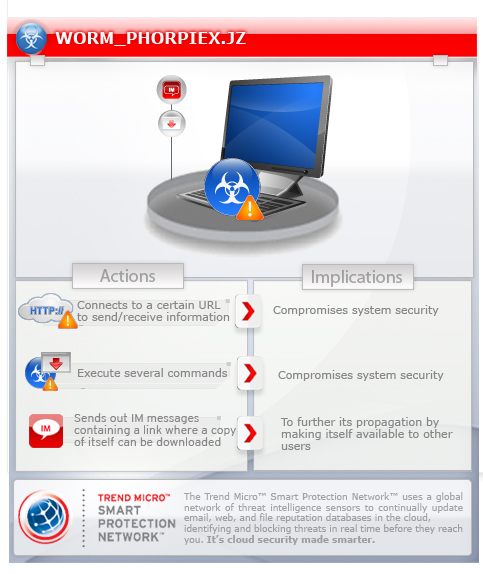WORM_PHORPIEX.JZ
VirTool:Win32/Obfuscator.ACP (Microsoft), Trojan.Win32.Jorik (Ikarus), Win32/Kryptik.AREB (NOD32)
Windows 2000, Windows Server 2003, Windows XP (32-bit, 64-bit), Windows Vista (32-bit, 64-bit), Windows 7 (32-bit, 64-bit)


Threat Type: Worm
Destructiveness: No
Encrypted: No
In the wild: Yes
OVERVIEW
This malware spams messages to users using Skype in order to propagate. The spammed messages contain links that lead to an automatic download of the malware itself. This malware also has backdoor routines, which compromises an affected system's security.
To get a one-glance comprehensive view of the behavior of this Worm, refer to the Threat Diagram shown below.

For the related story, you may read the blog post Shylock Not the Lone Threat Targeting Skype
This worm arrives as attachment to mass-mailed email messages. It arrives via removable drives.
It connects to Internet Relay Chat (IRC) servers. It executes commands from a remote malicious user, effectively compromising the affected system.
It deletes itself after execution.
TECHNICAL DETAILS
Arrival Details
This worm arrives as attachment to mass-mailed email messages.
It arrives via removable drives.
Installation
This worm drops the following copies of itself into the affected system and executes them:
- %User Profile%\6489672321067478425\winsvc.exe
(Note: %User Profile% is the current user's profile folder, which is usually C:\Documents and Settings\{user name} on Windows 2000, XP, and Server 2003, or C:\Users\{user name} on Windows Vista and 7.)
It adds the following mutexes to ensure that only one of its copies runs at any one time:
- g4u5f3dg4f
It terminates the execution of the copy it initially executed and executes the copy it drops instead.
Autostart Technique
This worm adds the following registry entries to enable its automatic execution at every system startup:
HKEY_CURRENT_USER\Software\Microsoft\
Windows\CurrentVersion\Run
Microsoft Windows Update = "%User Profile%\6489672321067478425\winsvc.exe"
Other System Modifications
This worm creates the following registry entry(ies) to bypass Windows Firewall:
HKEY_LOCAL_MACHINE\SYSTEM\CurrentControlSet\
Services\SharedAccess\Parameters\
FirewallPolicy\StandardProfile\AuthorizedApplications\
List
%User Profile%\6489672321067478425\winsvc.exe = "%User Profile%\6489672321067478425\winsvc.exe*:Enabled:Microsoft Windows Update"
Propagation
This worm drops the following copy(ies) of itself in all removable drives:
- {drive letter}:\843921.exe
Backdoor Routine
This worm connects to any of the following Internet Relay Chat (IRC) servers:
- {BLOCKED}50.asia
- {BLOCKED}50.in
- {BLOCKED}50.pro
It joins any of the following IRC channel(s):
- #go
It executes the following commands from a remote malicious user:
- Download and execute arbitrary files
As of this writing, the said servers are currently inaccessible.
Download Routine
This worm saves the files it downloads using the following names:
- %Application Data%\winsvcns.sys
(Note: %Application Data% is the current user's Application Data folder, which is usually C:\Documents and Settings\{user name}\Application Data on Windows 2000, XP, and Server 2003, or C:\Users\{user name}\AppData\Roaming on Windows Vista and 7.)
Other Details
This worm deletes itself after execution.
NOTES:
This worm creates .LNK (shortcut) files pointing to {drive letter}:\843921.exe in all removable drives using the folder names found in the removable drives.
It then hides the said folders.
This worm sends email messages containing a copy of itself as an attachment.
This worm queries the following mail server to harvest email addresses:
- gmx.com
The email it sends out has the following characteristics:
- Uses the following display names:
Anthony
Barbara
Betty
Brian
Carol
Charles
Christopher
Daniel
David
Deborah
Donald
Donna
Dorothy
Edward
Elizabeth
George
Helen
James
Jason
Jennifer
Joseph
Karen
Kenneth
Kevin
Kimberly
Laura
Linda
Margaret
Maria
Michael
Michelle
Nancy
Patricia
Richard
Robert
Ronald
Sandra
Sarah
Sharon
Steven
Susan
Thomas
William
- Subject:
Is this you??
Picture of you???
Tell me what you think of this picture
This is the funniest picture ever!
I cant believe I still have this picture
Someone showed me your picture
Your photo isn't really that great
I love your picture!
What you think of my new hair color?
What do you think of my new hair?
You look so beautiful on this picture
You should take a look at this picture
Take a look at my new picture please
What you think of this picture?
Should I upload this picture on facebook?
Someone told me it's your picture
- Body:
hahaha
;)
:D
:P
:)
LOL
;D
It uses the following file name for its attachment:
- IMG{random number}-JPG.zip
It does not have rootkit capabilities.
It does not exploit any vulnerability.
SOLUTION
Step 1
Before doing any scans, Windows XP, Windows Vista, and Windows 7 users must disable System Restore to allow full scanning of their computers.
Step 2
Scan your computer with your Trend Micro product and note files detected as WORM_PHORPIEX.JZ
Step 3
Restart in Safe Mode
Step 4
Delete this registry value
Important: Editing the Windows Registry incorrectly can lead to irreversible system malfunction. Please do this step only if you know how or you can ask assistance from your system administrator. Else, check this Microsoft article first before modifying your computer's registry.
- In HKEY_CURRENT_USER\Software\Microsoft\Windows\CurrentVersion\Run
- Microsoft Windows Update = "%User Profile%\6489672321067478425\winsvc.exe"
- Microsoft Windows Update = "%User Profile%\6489672321067478425\winsvc.exe"
- In HKEY_LOCAL_MACHINE\SYSTEM\CurrentControlSet\Services\SharedAccess\Parameters\FirewallPolicy\StandardProfile\AuthorizedApplications\List
- %User Profile%\6489672321067478425\winsvc.exe = "%User Profile%\6489672321067478425\winsvc.exe*:Enabled:Microsoft Windows Update"
- %User Profile%\6489672321067478425\winsvc.exe = "%User Profile%\6489672321067478425\winsvc.exe*:Enabled:Microsoft Windows Update"
Step 5
Search and delete these files
- {drive letter}:\843921.exe
- %Application Data%\winsvcns.sys
- {drive letter}:\{folder name}.lnk
Step 6
Restart in normal mode and scan your computer with your Trend Micro product for files detected as WORM_PHORPIEX.JZ. If the detected files have already been cleaned, deleted, or quarantined by your Trend Micro product, no further step is required. You may opt to simply delete the quarantined files. Please check this Knowledge Base page for more information.
Did this description help? Tell us how we did.



